|
|
|
|
| In 1969, I had a trying year as chairman of the Department of Anthropology; this was a time , in the midst of the Vietnam War, of general student unrest and demonstrations. To recover, I took a year’s leave of absence in 1970, to help to monitor the “Special Rural Development Programme” in Kenya. Bernard, who was still with the Department of Geography, was able to join me for much of the time. It was Bernard who saw the research possibilities of Siakago Division in Embu District, the area where we worked. As Bernard explained, Siakago is pie-shaped, the top lying on the lower slopes of Kirinyaga (Mount Kenya) , and the broad base being in the semi-arid Tana River Basin. There are three clearly defined ecological zones, from the fertile highlands to the drought-prone lowlands, providing excellent opportunities for comparative research.. |
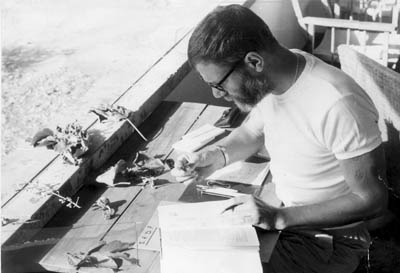 |
On return to UCSB, we were given a grant by the National Science Foundation to do a study of social and ecological change in the Mbeere area of Siakago, focussing on changes in uses and incidence of woody vegetation. Again, Bernard and I had complementary skills, well suited for this project. We spent fifteen months in the field in the first instance, but we realised that we needed longer. We were able to get more grants, and to spend varying periods, a total of two and a half years, in Kenya until 1987. We finally published a two volume book in 1988. (Bernard W. Riley & David Brokensha The Mbeere of Kenya. Vol 1, Changing Rural Ecology; Vol 2, Botanical Identities and Uses .) |
| The periods we spent in Kenya were
important for us, co-operating in our research, and experiencing daily
life ( at that time, mostly very pleasant) in a newly (1963) independent
African state. Our enquiries involved much fieldwork, in the true sense
of walking around the area, talking to local people, and to officials.
We were helped by relays of school-boys and school-girls, whom we recruited
to gather information for us in their school holidays. We selected them
carefully, paid them enough to cover most of their school fees, and explained
, in detail, what sort of information we wished them to collect. Bernard
was superb at the interaction with our young helpers, who looked forward
to his clear expositions, in the bush. They were diligent and reliable.
One of the best, Nthia Njeru, eventually came to UCSB to do a Ph.D with
us..
One of our main research aims was to identify the local woody vegetation, compiling a botanical dictionary of plants, including vernacular names, and uses, and noting changes in incidence – which was remarkable even in the relatively short time that we observed Mbeere. Bernard became a proficient, self-taught botanist, with invaluable help from Professor John Kokwaro of the University of Nairobi. One or two of the old guard, British botanists still in Kenya, were disparaging about Bernard’s efforts because he was not formally qualified in botany. These men were also scornful of “Indigenous Knowledge”, which Bernard and I - and John Kokwaro – had studied extensively, and we were all greatly impressed by what the local people knew about their vegetation. We were both fit then, and we much enjoyed our walks, often accompanied by a few of our young assistants. We also found that on every walk, we made at least one new discovery , either about the physical or the social world. .Bernard and I had had only a very superficial interest in birds, before we went to Siakago; there, the bird life was so abundant and varied that we soon became enthusiastic and later knowledgeable birders. The lowland areas in particular had many colourful and even rare birds, including several bright parrots. We never ventured out without our binoculars and our field guide to the Birds of East Africa. |
We stayed first in Ena, at what had been the British manager’s house for BAT, the British-American Tobacco Company. Having been left empty for a few years, it needed much renovation, but we soon made it ship-shape, and lived in comfort. We had a pump which gave us water from the Ena River, a parafin refrigerator, and a solid, well-built house. After hours spent in the field, we loved to come back to a hot bath ( the water heated by charcoal, in a 44 gallon drum, and ladled over ourselves with half a calabash). Then we would sit on the veranda, with a sundowner, identifying the many birds that settled near our home. |
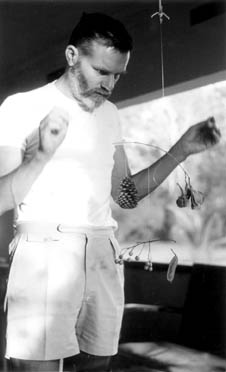 |
We also soon realised that we needed
to know more about snakes, which were plentiful in Mbeere. Joseph,
one of our young helpers saw, and immediately killed a green snake that
he spotted on our veranda. Bernard remonstrated with him, saying that it
was a harmless grass snake. When Joseph insisted that it was poisonous,
we decided to make sure, and put it in a jar of spirits, taking it
to be identified at the Nairobi Snake Park. The curator was quite excited,
because this was the first Green Mamba ( a deadly poisonous snake) recorded
north of the Tana River. In self-defence, we learned to be more accurate
in our identifications of local snakes.
On later visits, when the Ena home was not available, we stayed at the Catholic Mission in Siakago, where the kind Italian Consolata Fathers let us use their old home. From here we had a good view on a clear day of Kirinyaga, Mount Kenya. |
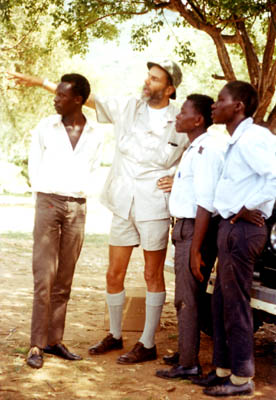 |
We taught Father Romano, headmaster of the Siakago Boys High School, the meaning of “TGIF”, and each Friday he would drive over to enjoy his one Scotch , and to ask us the meaning of various English words and idioms that he had collected during the week. We were friendly with Mr. Mehta, from India, who also taught at Siakago School, and his family. A dinner prepared by Mrs, Mehta was the culinary highlight of our stay at Ena. In Ghana, we had always had many African friends, who visited us frequently, but – probably because of the vastly different colonial experience (Ghana had no white settlers) – this was not the case in Kenya.. |
| We sometimes went in and out in a day, setting off before dawn, at 5 a.m., in time to have breakfast the Norfolk Hotel, when we would separate, Bernard doing 101 shopping errands, and I calling at governemt offfices. We would meet for a samoosa and fresh orange drink at the KitKat Café, in Mwindi Mbingu Street, opposite the market, at 1 p.m, then finish our last few calls, setting off before 4 p.m. both to avoid the commuter traffic, and to be home, for a much needed sundowner, by dusk. On our early morning drives we saw, in the headlights of the vehicle, an occasional leopard, and many ratels ( honey badgers..) Once, we set off in heavy rain, because of some now forgotten urgent need to be in Nairobi. We had, fortunately, given Mr.Jaggi, the local Indian trader, a lift. I was driving, and Mr.Jaggi helped Bernard push the Peugeot 404 out of muddy patches. As we crossed a flooded bridge, where the water was already up to the hub caps, the Peugeot started sliding, ominously, to the edge, and it took all of Bernard’s and Mr.Jaggi’s efforts to keep the car from sliding over. They managed it, but Bernard injured his back, and the doctor whom we saw in Nairobi ordered a week in bed. We stayed at a pleasant flat in Heron Court, while the rain continued in full spate; on the first night, 7’’ (180mm) was recorded, causing enormous damage in the low-lying informal settlements. |
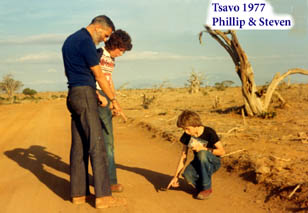 |
When we were in Kenya, we invited several friends to visit, taking advantage of their presence to do explore more of our surrounds. . With Dora Seu, whose family had been so hospitable to us in Hawaii, we drove to Uganda . Other visitors included my Scottish great-nephews , Philip and Steven, 14 and 11. Their arrival coincided with a period of unrest, following the death of the first President, Jomo Kenyatta. Nairobi was tense, and we made elaborate contingency plans for Philip and Steven, in case we were unable to meet them at the airport.. However, all was well. Young Steven was interested in birds, and in his three week stay he reached his target of 200 different species; during that time, we did visit a variety of habitats, including both coast and mountains. He saw his 200th bird on the airport, before departure. |
Adam, my god-son, then eleven years old, stayed with us en route to his parents in Indonesia. Colin Ainley, son of old Tanga friends, spent his 21st birthday with us, on a picnic at Olorgeosailie., site of Mary Leakey’s exciting archeological discoveries. We always visited the game parks with our visitors, staying in “self-service bandas”.. these visits were in the 1970’s and early 1980’s, when conditions ( travel, security, roads, accommodation) in Kenya were better than they are today. |
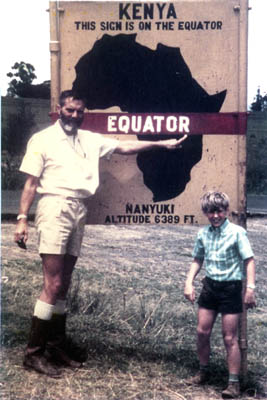 |